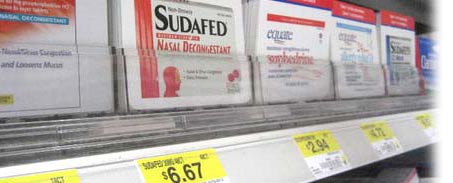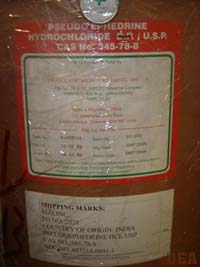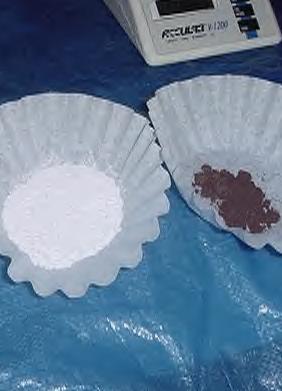|
HOME >>
Pharmaceuticals API List 2 >>
Pseudoephedrine hydrochloride


|
Pseudoephedrine
hydrochloride


|
Molecular Formula :
C10H16ClNO
Molecular Weight :
201.69
CAS No. :
345-78-8
Chemical Name:
1. (1S,2S)-2-Methylamino-1-phenyl propan-1-ol, Hydrochloride
2. Benzenemethanol, a-[1-(methylamino)ethyl]-, [S-(R*,R*)],
Hydrochloride
Synonyms:
(+)-PSI-EPHEDRINE HYDROCHLORIDE;PSI-EPHEDRINE
HYDROCHLORIDE;PSEUDOEPHEDRINE HCL;PSEUDOEPHEDRINE HCL,
(+)-1S,2S-;(+)-PSEUDOEPHEDRINE HYDROCHLORIDE;PSEUDOEPHEDRINE
HYDROCHLORIDE;a)]-;alpha-(1-(methylamino)ethyl)-,hydrochloride,(s-(r*,r*))-benzenemethano;benzenemethanol,alpha-[1-(methylamino)ethyl]-,hydrochloride,[s-(theta,thet;hydrochloride,l-(+)-pseudoephedrin;l(+)-
pseudoephedrinehydrochloride;novafed;sinufed;sudafed;symptom2;tussaphed;D-PSEUDOEPHEDRINE
HYDROCHLORIDE;D-ISOEPHEDRINE HYDROCHLORIDE;ISOEPHEDRINE
HYDROCHLORIDE;(1S,2S)-2-(METHYLAMINO)-1-PHENYL-1-PROPANOL
HYDROCHLORIDE
Specifications :
| 1. |
Description : |
Fine, white
to off white crystals or powder. |
| 2. |
Identification : |
a ) Infrared
spectrum of sample is concordant with the
reference spectrum.
b) A solution of sample responds to the test for chloride |
| 3. |
Melting range : |
Between 182°
and 186°C; the range between beginning
and end of melting does not exceed 2°C |
| 4. |
Specific rotation : |
Between +
61.0° and + 62.5° (5 % solution in water) |
| 5. |
Solubility : |
Very soluble
in water and freely soluble in alcohol. |
| 6. |
pH : |
Between 4.6
and 6.0 (5 % solution in water) |
| 7. |
Ordinary impurities : |
NMT 2.0 % |
| 8. |
Residue on ignition : |
NMT 0.1 % |
| 9. |
Loss
on drying : |
NMT 0.5 % |
| 10. |
Organic volatile impurities : |
Must pass the test |
| 11. |
Assay
: |
Between 98.0 % and 100.5 % (
dried basis ) |
Therapeutic indications : Decongestant Packing
: Packed in double lined polyethylene bags in 25 kg fiber drums.
Storage : Store below 35°C. |
Pseudoephedrine is a sympathomimetic amine commonly used as a decongestant. The
salts pseudoephedrine hydrochloride and pseudoephedrine sulfate are
found in many over-the-counter preparations either as
single-ingredient preparations, or more commonly in combination with
antihistamines, paracetamol (acetaminophen) and/or ibuprofen.
Sudafed is a trademark for a common brand which contains
pseudoephedrine hydrochloride, though Sudafed PE does not. Cirrus
contains pseudoephedrine in conjunction with cetirizine (an
antihistamine).
Unlike antihistamines, which relieve multiple allergic symptoms by
acting as antagonists at histamine receptors, pseudoephedrine
primarily relieves nasal congestion commonly associated with colds
or allergies.
The advantage of oral pseudoephedrine over topical nasal
preparations, such as oxymetazoline, is that it does not cause
rebound congestion (rhinitis medicamentosa); however, it is more
likely to cause adverse effects including hypertension.
Pseudoephedrine is being phased out as an over-the-counter drug in
some countries and replaced by less effective.
Chemistry
Pseudoephedrine is a phenethylamine, and a diastereomer of
ephedrine. Pseudoephedrine is a chiral molecule, meaning it occurs
in both "left-handed" and "right-handed" configurations which are
not superimposable.
Pseudoephedrine is the International Nonproprietary Name (INN) of
the (1S,2S)- diastereomer of ephedrine (which has 1R,2S-
configuration). Other names are (+)-pseudoephedrine and D-pseudoephedrine.
L-Pseudoephedrine, also known as (-)-(1R,2R)-pseudoephedrine or (-)-pseudoephedrine,
is the optical isomer of D-pseudoephedrine. It has fewer
side-effects, fewer central nervous system (CNS) stimulatory
effects, does not reduce to D-methamphetamine (which is the
enantiomer used as a recreational drug), and yet it retains its
efficacy as a decongestant.[citation needed] However, the patent
holder for L-pseudoephedrine (Pfizer/Warner-Lambert)[has not yet
sought or received government approval for its sale to the public.
Clinical uses
Indications
Pseudoephedrine is indicated for the treatment of:
* nasal congestion
* sinus congestion
* Eustachian tube congestion.
Pseudoephedrine is also indicated for vasomotor rhinitis, and as an
adjunct to other agents in the optimum treatment of allergic
rhinitis, croup, sinusitis, otitis media, and tracheobronchitis.
Adverse effects
Common adverse drug reactions (ADRs) associated with pseudoephedrine
therapy include: CNS stimulation, sleeplessness, nervousness,
excitability, dizziness and anxiety. Infrequent ADRs include:
tachycardia and/or palpitations. Rarely, pseudoephedrine therapy may
be associated with hallucinations, arrhythmias, hypertension,
seizures and ischemic colitis;as well as severe skin reactions known
as recurrent pseudo-scarlatina, systemic contact dermatitis, and
nonpigmenting fixed drug eruption.Pseudoephedrine, particularly in
high doses, may also cause episodes of paranoid psychosis.It has
also been reported that pseudoephedrine, amongst other
sympathomimetic agents, may be associated with the occurrence of
stroke.
 Note:
These API/ chemicals are designated as those that are used in
the manufacture of the controlled substances and are important to
the manufacture of the substances. For any (Control Substance)
products Import and Export *** subjected to your country government
laws /control substance ACT. Note:
These API/ chemicals are designated as those that are used in
the manufacture of the controlled substances and are important to
the manufacture of the substances. For any (Control Substance)
products Import and Export *** subjected to your country government
laws /control substance ACT.
Note /Government Notification:
These chemicals are designated as those that are used in the
manufacture of the controlled substances and are important to the
manufacture of the substances. For any (Control Substance) products
Import and Export *** subjected to your country government laws
/control substance ACT.
Information: The information on this web page is provided to
help you to work safely, but it is intended to be an overview of
hazards, not a replacement for a full Material Safety Data Sheet (MSDS).
MSDS forms can be downloaded from the web sites of many chemical
suppliers. ,also that the information on the PTCL Safety web site,
where this page was hosted, has been copied onto many other sites,
often without permission. If you have any doubts about the veracity
of the information that you are viewing, or have any queries, please
check the URL that your web browser displays for this page. If the
URL begins "www.tajapi.com/www/Denatonium Benzoate.htm/" the page is
maintained by the Safety Officer in Physical Chemistry at Oxford
University. If not, this page is a copy made by some other person
and we have no responsibility for it.
The Controlled Substances Act (CSA) was enacted into law by the
Congress of the United States as Title II of the Comprehensive Drug
Abuse Prevention and Control Act of 1970.[1] The CSA is the federal
U.S. drug policy under which the manufacture, importation,
possession, use and distribution of certain substances is regulated.
The Act also served as the national implementing legislation for the
Single Convention on Narcotic Drugs.

|

Also Available :
| (d) - Pseudoephedrine Sulphate |
[ 7460 - 12 - 0 ]
|
| (d) - Pseudoephedrine Base |
[ 90 - 82 - 4 ]
|
| (l) - Pseudoephedrine
Hydrochloride |
[ 670 - 40 - 6 ]
|
| (l) - Pseudoephedrine Base |
[ 321 - 97 - 1 ]
|
|













